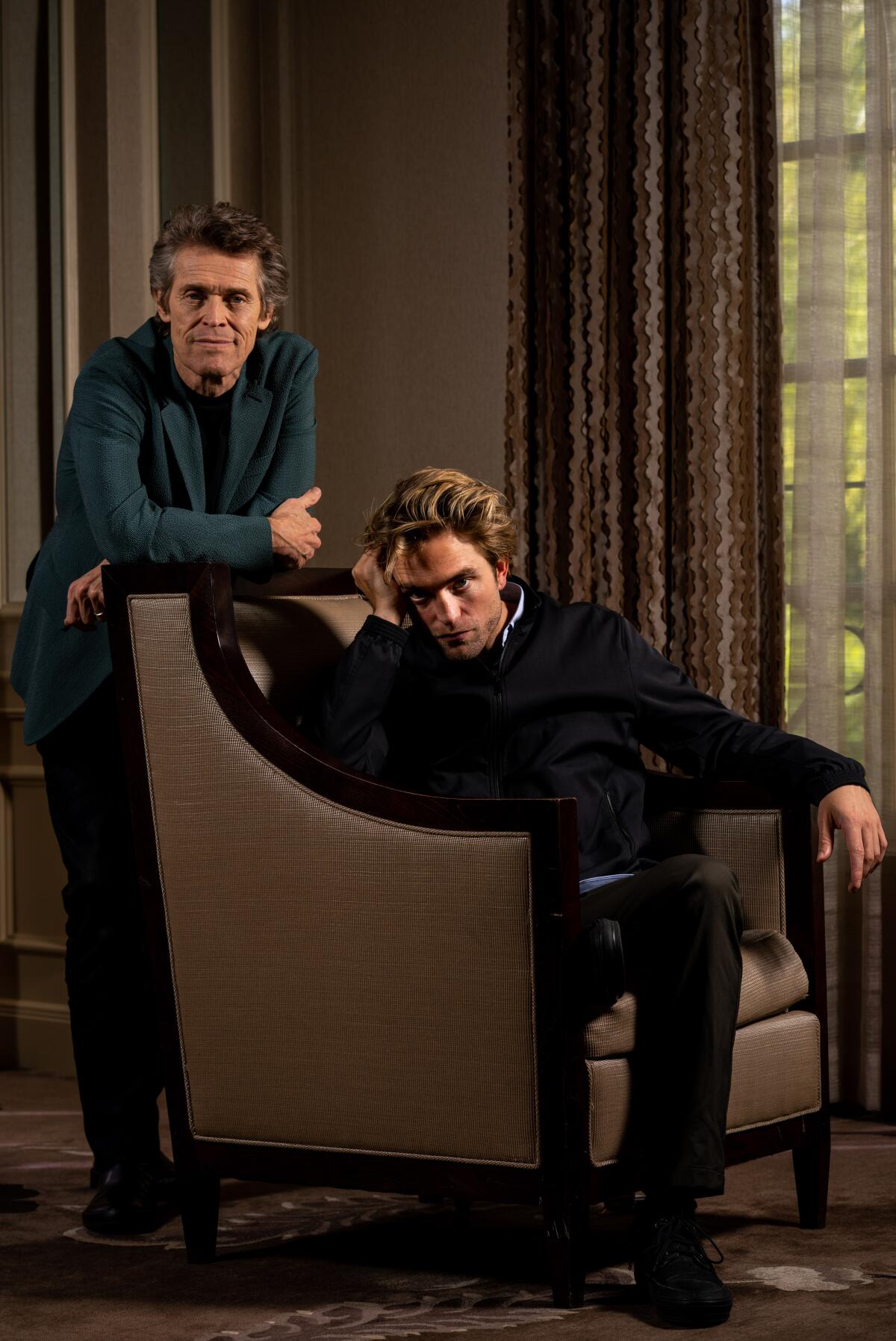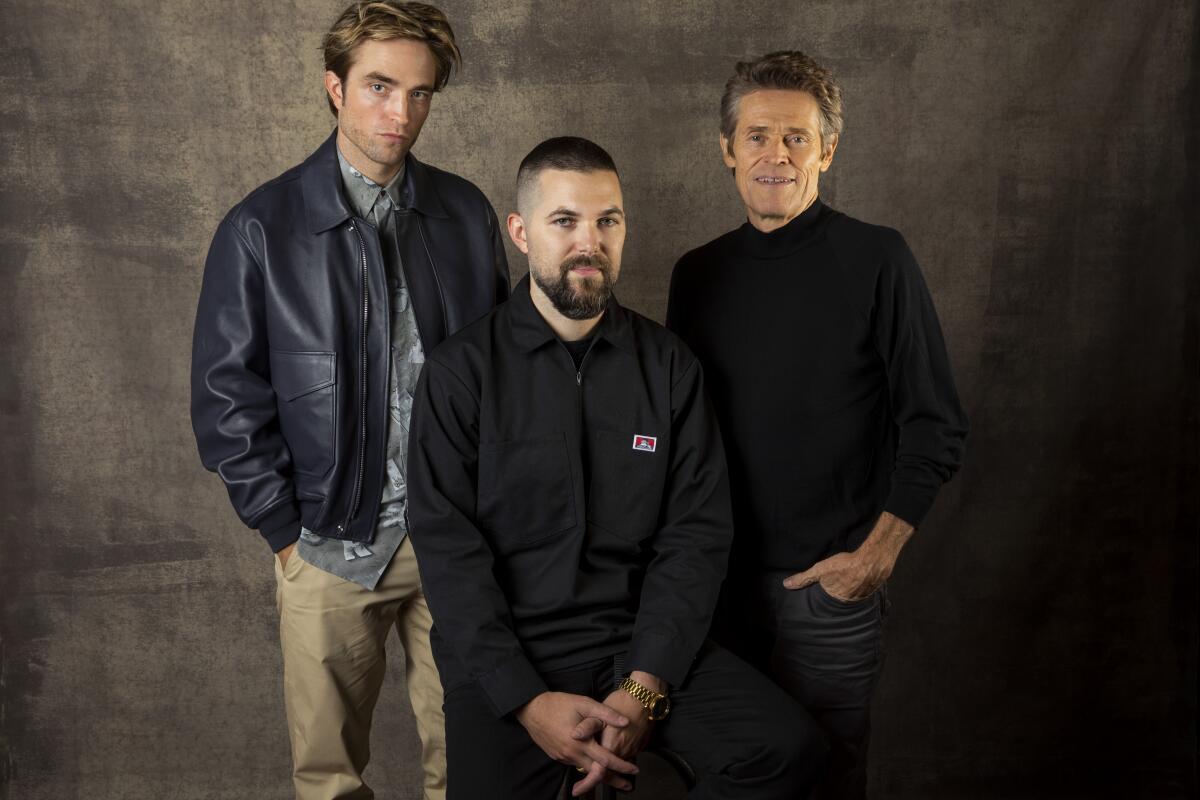Robert Pattinson, Willem Dafoe and the ‘orgasm that won’t stop’ in ‘The Lighthouse’

- Share via
Robert Pattinson knows he needs to stop talking about masturbation.
Case in point: At a Q&A last weekend for “The Lighthouse,” the loopy, claustrophobic chamber piece that pairs him with Willem Dafoe, Pattinson couldn’t even bring himself to say the word when asked about a scene in which his character engages in self-abuse so furiously that the euphemism “self-abuse” actually applies.
And yet, shortly afterward, sitting across from Dafoe in the sleek Pacific Design Center office space of indie film distributor A24, Pattinson admits that he’s been purposefully leaning into the subject while doing interviews for “The Lighthouse.” A friend just sent him a screenshot of headlines featuring his name and masturbation, asking in a follow-up text, “So ... um ... how exactly are you promoting this movie?”
“I do find it quite entertaining,” Patttinson says, chuckling. “It definitely gets people talking about the film.” He pauses, considering. “I don’t know if it gets people to actually see the film.” He bursts out laughing at the thought. “The other day, I was saying to A24, ‘I’m not sure how successful I am at doing this promotional stuff.’”
Dafoe chimes in, purring: “Was it good for you?”
“The Lighthouse,” which opened last weekend to an enviable per-screen average and expands nationwide this weekend, doesn’t lack for topics to discuss. It’s a late 19th century tale of two lighthouse keepers, “wickies,” to use the parlance of the times — Ephraim Winslow (Pattinson) and Thomas Wake (Dafoe) — trying to keep madness at bay when a powerful storm hits their desolate New England island station. Director Robert Eggers shot the film in black-and-white and in a boxy aspect ratio that accentuates the story’s prevailing cabin fever.
As for the story, there are sex dreams about mermaids, ill-tempered seagulls who seem possessed, flatulence employed as “deliberate displays of power,” visions of Dafoe’s Thomas as Poseidon (and as a mermaid!) and, at its center, the mystery of the lighthouse itself, a secret Thomas seems to understand, greedily guarding his knowledge from Ephraim.
“People see what they want to see,” Dafoe says, delighting in the film’s ambiguity. “Some people talk about a father-son story. Some people see it as boss and employee, master and apprentice. Some people dig into the homoerotic stuff. Some people just like the farts.”
The movie’s leads have little in common other than their angular features or, as Eggers puts it, “four of the finest cheekbones to ever grace the Earth.” They did both love Eggers’ first film, the unsettling Puritan-set horror story “The Witch,” and separately approached the filmmaker, indicating an interest in collaborating.
But the actors part ways when it comes to preparation. During rehearsal, Pattinson prefers to talk about the script; Dafoe, citing his theater days with the experimental Wooster Group, just wants to dive in, holding nothing back. Dafoe never stops performing. Pattinson needs the adrenaline shot that comes when the camera rolls, the “controlled moment between action and cut where it’s too late for everyone.” Too late? “You can’t get fired,” Pattinson elaborates, laughing.
Job security was low on the list of concerns of a production that filmed at Cape Forchu in Nova Scotia, where production designer Craig Lathrop and his team built a full-scale lighthouse station. The weather was windy and freezing cold. And when conditions weren’t nasty enough, Eggers turned on a fire hose to douse Pattinson, as the actor trudged around the barren landscape hauling a wheelbarrow full of coal.
The latest thriller written and directed by Robert Eggers (“The Witch”) is a stormy, magnificently crafted 19th century gothic.
“That was actually exhilarating,” Pattinson says. “Anything that makes you not have to act. Willem can actually act. I have to literally just say, ‘Please hit me with a shovel.’ So I appreciate the fire hose at the end of the day.”
“How do I deal with this charming self-deprecation?” Dafoe asks. And he really means it. Since the actors kept their distance throughout the shoot, they’re just now getting to know each other. Pattinson offers an observation about Dafoe’s acting technique, prompting Dafoe to cry, “I don’t have technique! I have instinct!”
Mostly, as is the case with their characters, Dafoe drives the conversation, expounding on turning language into song and then back into normal conversation, mixing it up, stripping it down, submitting to the camera for the film’s parade of claustrophobic close-ups. Pattinson listens thoughtfully and then interjects a dry observation about what happens to your face when you’re trying to emote in such a tight space.
“It’s funny what comes out,” he says. “You end up trying to push the limits of what your eyeballs can squeeze out.”
Pattinson is tasked with squeezing out an ocean of fear and loathing throughout “The Lighthouse” — contempt for Thomas’ long-winded yarns (“you sound like a parody”), his nagging and his snoring and, yes, his flatulence. (Thomas’ hygiene and cooking aren’t things to write home about, either.)

But mostly (and mild spoilers ahead), the conflict boils down to Thomas withholding the light. There’s a scene early in the film showing Thomas ecstatically basking in its glow and saluting it, giving it what Dafoe calls the “feeling of the sacred.”
“It’s a precious thing that he won’t share until [Ephraim] becomes a believer like me,” Dafoe says. “I’ve dedicated my life to this thing, and this guy is not getting on board. That’s a very interesting story about how people cling to the sacredness of the life they make for themselves and what happens when someone comes along and threatens that. It goes beyond the bullying of a boss. It runs much deeper.”
As for the movie’s ending (and you should only read the following after you’ve seen “The Lighthouse” — which you should definitely view in a theater because the movie’s almost-square aspect ratio will look weird on your TV or laptop), Pattinson doesn’t know for certain what happens when his character finally sees the light. But he does remember what Eggers told him when he shot his close-up.
“He said looking at the light was so pleasurable that it starts to become incredibly painful and then incredibly frightening afterward. It’s just an orgasm that won’t stop.” Pattinson laughs. “I was thinking, ‘I can get that. I can relate.’”
More to Read
Only good movies
Get the Indie Focus newsletter, Mark Olsen's weekly guide to the world of cinema.
You may occasionally receive promotional content from the Los Angeles Times.











